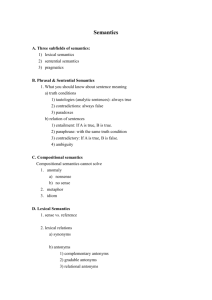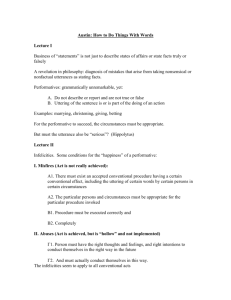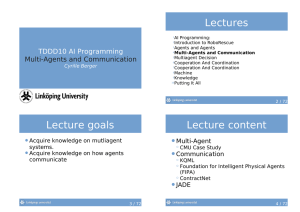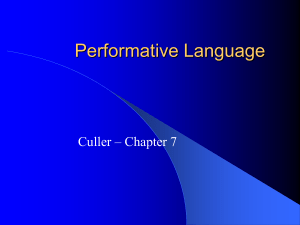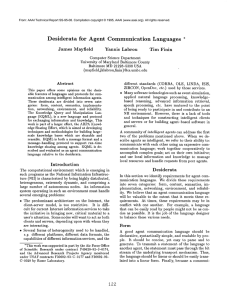P e r f o r m a t i... D e s i g n i n g ... Mauro Gaspari Dipartimento di Scienze dell'Informazione
advertisement
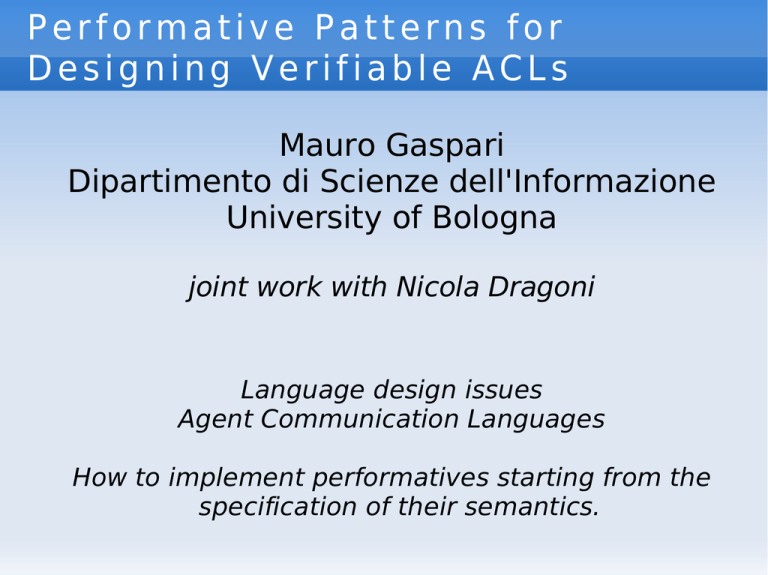
Performative Patterns for
Designing Verifiable ACLs
Mauro Gaspari
Dipartimento di Scienze dell'Informazione
University of Bologna
joint work with Nicola Dragoni
Language design issues
Agent Communication Languages
How to implement performatives starting from the
specification of their semantics.
Outline
●
The problem:
–
Are performatives “just” messages?
–
How to deal with failures of agents.
●
Our solution: Performative patterns.
●
Classification of ACL performatives.
●
Discussion
–
Main features of our approach
–
ACL semantics and implementation
Are performative
messages?
Yes --> to send performative as contents of
asynchronous message passing primitives
[JADE PROGRAMMER'S GUIDE]:
“...An agent willing to send a message should create a
new ACLMessage object, fill its attributes with
appropriate values, and finally call the method
Agent.send(). Likewise, an agent willing to receive a
message should call receive() or blockingReceive() ...”
Observation
Following this approach all the performatives are
transmitted in the same way.
More precisely: the concurrent semantics is the
same for all of them. Informally: the performative
(ACLmessage object) is transmitted in a queue
associated to the recipient agent
send(ask(B,A,p))
A
B
ask(B,A,p)
send(insert(B,A,p))
A
B
insert(B,A,p)
declarative semantics
insert(B, A, p)
Informally: agent A asks agent B to insert a
proposition p in its Knowledge Base
KQML semantics (Labrou):
......
Post(A): know(A, bel(B,p))
Post(B): bel(B, p)
implication
The KQML insert performative is not “just” a
message.
send(insert(B,A,p))
A
know(A,bel(B,p))
bel(B,p)
B
ack
p
insert(B,A,P)
This depends on the “declarative”
semantics of KQML
Advantages of the KQML
approach
Expressive power!
The insert performative is more powerful then a single
message!
For example: after executing an insert successfully
we can infer that both A and B believe p (KS(p))
However this intended meaning cannot be
implemented with a single performative following the
JADE approach: the implementation becomes more
complex
Is JADE correct?
yes!
JADE is conform to the FIPA semantics
FIPA assumes asynchronous communication actions
FIPA ACL's semantic model is based on the rational
effect of each performative
what the sender agent hopes to obtain
by sending the message
Thus there no assumptions on the state of the
recipient agent that the sender agent should know
Limitations of JADE (FIPA)
It is not possible to infer properties such as KS(p) in
JADE after a single communication action:
at least two communications are needed
A:
send(inform(B,A,p))
blockingReceive()
B:
send(inform(A,B,bel(B,p)))
an extra speech act mechanism is needed: a
blockingReceive()
What we have learned
there is a tradeoff between the expressive power of
the ACL semantics and the complexity of the
implementation
where complexity in this context does not mean
computational complexity but concurrent
complexity
However, although the JADE implementation is more
complex it is possible to infer a property like KS(p) in
both the approaches
Distributed MAS
WEB based MAS: failures (crashes) of agents are
possible
Suppose that agent B crashes,
is the previous JADE implementation of insert correct?
Dealing with agent
crashes in JADE
First a timeout t is needed in the receive primitive:
send(inform(B,A,p))
blockingReceive(t)
Then the result of the receive should be considered:
send(inform(B,A,p))
result = blockingReceive(t)
if result = -1 then {timeout - retry?}
else {KS(p) holds}
However, it is not clear how to implement the
retry policy:
1) should the agent send the inform performative
again?
2) or should the agent execute another
blockingReceive waiting for some more time?
Problems
The number of extra speech act primitives increases!
Is this high level human like communication?
The programmer needs to solve many low level
programming issues, for example:
- establish the correct timeout
- establish the correct action when a retry is needed
Our claims
●
There is a relationship between the declarative
semantics of a performative and how a retry operation
should be realized.
●
In most cases an agent needs to be aware of the
fact that its partner has crashed.
●
Some (low level) crash handling operations can be
hidden in the failure handling mechanisms (for
example a criteria to establish when an agent is
considered crashed).
●
Some (knowledge level) crash handling actions
should be “attached” to performatives by the
programmer (for example, finding another partner).
Definitely, performatives are not “just” messages!
Our approach
We also assume asynchronous communication.
We deal with crash failures of agents.
We extend the abstract syntax of performatives
adding optional failure and success continuations to
the communication act:
insert(B,A,p)[on_ack + on_fail]
We have recognized that some performatives may
share the same interaction model.
We have defined a set of performative patterns to
characterize common interaction models.
Performative Patterns
performative(A,B,p)[success_continuation + failure_continuation]
Do action with ack
insert(B,A,p)[on_ack(P1) + on_fail(P2)]
perf_name(B,A,p)[on_ack(P1) + on_fail(P2)]
Request and Answer
• Performative Templates:
∗ request_name(B, A, K)[on_answer(P1 ) + on_fail(P2 )]
∗ answer_name(A, B, K)
Request and answers
• Performative Templates:
∗ request_name(B, A, K)[on answer(P1 ) + on fail(P2 )]
∗ answer_name(A, B, K)
∗ end_name(A, B, K)
Request to everybody
• Performative Templates:
∗ request_name(A, K)[on_answer(P1) + on_fail(P2)]
∗ answer_name(A, B, K)
• Predicates:
∗ all-answers(K): returns true if all the replies about K have been received
Classification of Standard
Perdormatives
Conclusions
●
Performatives are not “just” messages!
●
Our language FT-ACL:
●
–
Concurrency aspects and Knowledge-Level
programming
–
It includes most of the performative patterns.
–
It deals with crash failures of agents.
–
It provides anonymous requests for knowledge.
Semantics:
–
Weak declarative semantics
–
Strong concurrent semantics
Conclusions
Performative patterns can be used to implement
performatives starting from the specification of a
declarative semantics.
But not all the semantics can be implemented in a
distributed system.
There is a tradeoff between the expressive power of
an ACL (semantics) and the concurrent complexity
(implementation)
SEMANTICS
FIPA ACL
JADE MESSAGES
tractable
KQML
KQML API
IMPLEMENTATION
???
not tractable
SOCIAL
PERF. PATTERNS
COMMON KNOWLEDGE
Not tractable
in asynchronous
distributed systems
References
Knowledge-Level programming and concurrency:
M. Gaspari, Concurrency and Knowledge-Level Communication in Agent
Languages. Artificial Intelligence 105(1-2) (1998) 1–45
Definition and Semantics of FT-ACL:
N. Dragoni and M. Gaspari. Crash Failure Detection in Asynchronous Agent
Communication Languages. International Journal of Autonomous Agents and
Multi-Agent Systems, 13(3): 355–390, 2006.
Implementation of FT-ACL:
N. Dragoni, M. Gaspari, and D. Guidi. A Reasoning Infrastructure to Support
Cooperation of Intelligent Agents on the Semantic Grid. International Journal
of Applied Intelligence, 25(2): 159–180, 2006.
Knowledge-Level Programming in FT-ACL:
N. Dragoni, M. Gaspari, and D. Guidi. An ACL for Specifying Fault-Tolerant
Protocols, To appear in Applied Artificial Intelligence.


